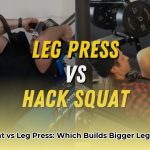Ever walk into a gym and feel completely lost? So many machines, so many strange names… it’s enough to make anyone want to run straight back out! This guide is your key to unlocking the mystery of gym equipment. We’ll break down all those confusing names, show you pictures of the machines, explain what muscles they work, and even give you tips on choosing the right equipment for your fitness goals, whether you’re a beginner just starting out or a pro looking to level up. Whether you’re planning a home gym or hitting up the local fitness center, this guide will help you navigate the world of weights, cardio, and everything in between, making your workouts more effective and—dare we say—even fun!
Gym Machine Names: Your 2025 Fitness Equipment Guide
Navigating the world of fitness equipment can be daunting, especially with all the specialized machines and jargon. This guide breaks down the different machines, helping you navigate the fitness landscape and find what best suits your needs, and understand fitness terminology. Forget the confusing jargon – we’ll keep it simple and straightforward.
Free Weights: The Foundation of Fitness and Muscle Building
Dumbbells and barbells – the classic free weights – are fundamental to building strength. Unlike machines, they require you to use more of your stabilizing muscles, leading to functional strength. Think about it: you use this kind of strength in everyday life, not just in the gym. Exercises like squats, deadlifts, and bench presses are prime examples. These compound movements work multiple muscle groups at once, maximizing your workout efficiency. Many gym-goers find that the freedom and adaptability of free weights are essential for long-term progress.
Are free weights the right choice for you? It depends. If you’re just starting out, you might find guided machines a better option at first, to get the hang of proper form and prevent injuries. However, as you build experience and strength, free weights offer unparalleled versatility and challenge. They allow you to tailor the workout exactly to your needs and preferences. Research indicates that the instability inherent in free weight exercises may lead to greater muscle activation and overall fitness improvement.
Weight Machines: Precision and Control in Strength Training
Machines like the leg press, chest press, and lat pulldown offer a more controlled and targeted approach to strength training, facilitating injury prevention. They guide your movements, minimizing the risk of injury, making them ideal for beginners or those recovering from an injury. This precision comes from the machine’s structure – it essentially “guides” your movement along a predetermined path. However, this precise guidance also means that your stabilizing muscles may not work as hard compared to free weights. You’re getting a targeted workout, but at the cost of some functional strength development. The trade-off is a safer, more isolated experience which can be advantageous for specific goals.
| Machine Type | Target Muscle Groups | Pros | Cons |
|---|---|---|---|
| Leg Press | Quads, glutes, hamstrings | Isolates leg muscles, reduces back strain | Less functional movement than squats |
| Chest Press | Pectorals, triceps | Targeted chest activation, controlled motion | Limited range of motion compared to bench press |
| Lat Pulldown | Lats, biceps, forearms | Great back exercise, varying grips possible | May not fully engage stabilizing muscles |
| Cable Crossover | Chest, shoulders, triceps | Versatile, allows for various angles | Can be overwhelming for beginners |
| Smith Machine | Multiple muscle groups, depending on exercise | Guided movement, improved safety | Can limit range of motion, less functional |
Cardio Equipment: Boosting Your Heart Health and Endurance
Cardio equipment is essential for overall health and well-being. Familiar names like treadmills, ellipticals, stationary bikes, and rowing machines all offer unique cardiovascular workouts. Treadmills are great for running and intervals; ellipticals provide a low-impact, full-body workout; stationary bikes are perfect for a steady-state cardio session; and rowing machines offer a full-body, low-impact challenge. The best machine for you depends entirely on your personal preferences and fitness goals. Many serious athletes incorporate several types of cardio into their training regimen. For example, they might start the session on an elliptical for a warm up and then progress to interval running on the treadmill. This versatility is very significant. Choosing the best cardio machines probably requires some experimentation.
Consider these popular options.:
- Treadmills: Simulate natural running or walking motion; good for interval training.
- Ellipticals: Low-impact, full body movement; good for sustained cardio.
- Stationary bikes: Effective, low-impact cardio; good for all fitness levels.
- Rowing machines: Full-body workout; good for strength and cardio.
Functional Training Tools: Going Beyond Traditional Machines for Fitness
Beyond the traditional weight machines and cardio equipment, you’ll find functional training tools gaining immense popularity. TRX suspension trainers, kettlebells, medicine balls, and battle ropes challenge your body in new ways, focusing on coordination, balance, and core strength. These tools mimic movements you perform in daily life, improving your functional fitness – the kind of strength and agility you use every day. They’re incredible for building stamina and overall body awareness. This approach to fitness provides a more adaptable skill set for activities outside the gym environment.
Examples of functional training tools include:
- TRX Suspension Trainers: Leverage bodyweight for a full-body workout.
- Kettlebells: Offer versatile strength and cardio training.
- Medicine Balls: Great for power and core work.
- Battle Ropes: Provide a high-intensity cardio and strength workout.
Specialized Gym Equipment: Targeting Specific Needs
Beyond the common machines, many gyms offer specialized equipment catering to specific training goals or physical needs:
- Assisted Pull-Up Machine: Helps users perform pull-ups by counterbalancing weight.
- Glute-Ham Raise (GHR) Machine: Isolates the hamstrings and glutes for strength development.
- Reverse Hyper Machine: Targets the lower back and glutes with a unique range of motion.
Choosing the Right Equipment: A Personal Fitness Journey
Picking the right gym equipment is a very personal decision. To guide your choices, consider these factors:
- Your Goals: Are you aiming for strength training, muscle building, cardiovascular improvement, or a combination? Different equipment excels in different areas.
- Your Experience: Beginners may be better off starting with machines to ensure proper form and minimize risk of injury, while more advanced users might prefer the challenge of free weights. There is some debate on the ideal starting point for individuals based on their pre-existing fitness levels.
- Your Budget: Free weights are generally more affordable than many machines. Home gym setups generally lean toward more affordable options.
- Available Space: A home gym requires space-saving equipment, while commercial gyms offer a wider variety of options.
- Your Physical Condition: Consider any pre-existing injuries or physical limitations when choosing equipment. Low-impact options are available for those with joint pain or mobility issues.
Remember, a well-rounded fitness routine likely involves a mix of equipment types. Don’t be afraid to try different machines and find what you enjoy and what works best for you. Your fitness journey is unique and personal! The variety of gym equipment is just a tool to help you reach your full potential. The best way to learn is to try, analyze and adjust your approach as your fitness goals evolve.
Best Home Gym Equipment for Muscle Hypertrophy and Strength Gains
Building a home gym can be a game-changer for your fitness routine, offering convenience and privacy. Focusing on muscle hypertrophy (muscle growth) and strength gains requires a strategic selection of equipment.
Key Takeaways:
- Versatility is king: Choose equipment that allows for a wide range of exercises targeting multiple muscle groups.
- Budget matters: Determine your price range before selecting equipment. Options range from affordable setups to high-end systems.
- Space is crucial: Consider your available space when choosing equipment size and configuration. Compact and foldable options exist.
- Prioritize durability: Invest in well-built equipment from reputable brands known for longevity.
- Consider smart features: Smart home gym options offer convenient workout tracking and guided programs.
Free Weights: The Foundation of Strength Training for Home Gyms
Free weights, like dumbbells and barbells, are cornerstones of any serious strength training program. Why? They demand more balance and stabilization, leading to greater overall muscle activation. Think of them as the ultimate muscle builders.
For best home gym equipment for muscle hypertrophy (muscle growth) and strength gains, a barbell and a good selection of dumbbells are essential. This allows for compound movements like squats, deadlifts, and bench presses – crucial for building overall strength and muscle mass.
- Barbells: Offer a wide range of exercises. Excellent for compound movements. Look for Olympic barbells with a weight capacity suitable for your strength level.
- Dumbbells: Versatile and adaptable. Perfect for unilateral exercises to address muscle imbalances. Consider adjustable dumbbells to save space and money.
- Adjustable dumbbells: Space-saving alternative. Offers a range of weights without needing multiple sets. Brands like PowerBlock and Bowflex offer popular adjustable dumbbell solutions.
Weight Machines: Targeted Muscle Growth with Home Gym Machines
Weight machines offer a more guided approach, reducing the risk of injury for
- Unlock Young Doctors’ Work-Life Balance: Actionable Strategies Now - December 2, 2025
- Unlock Life Harmony: Work-Life Integration Guide - November 30, 2025
- Unlock Work-Life Harmony:Your Guide to Integration - November 27, 2025
















